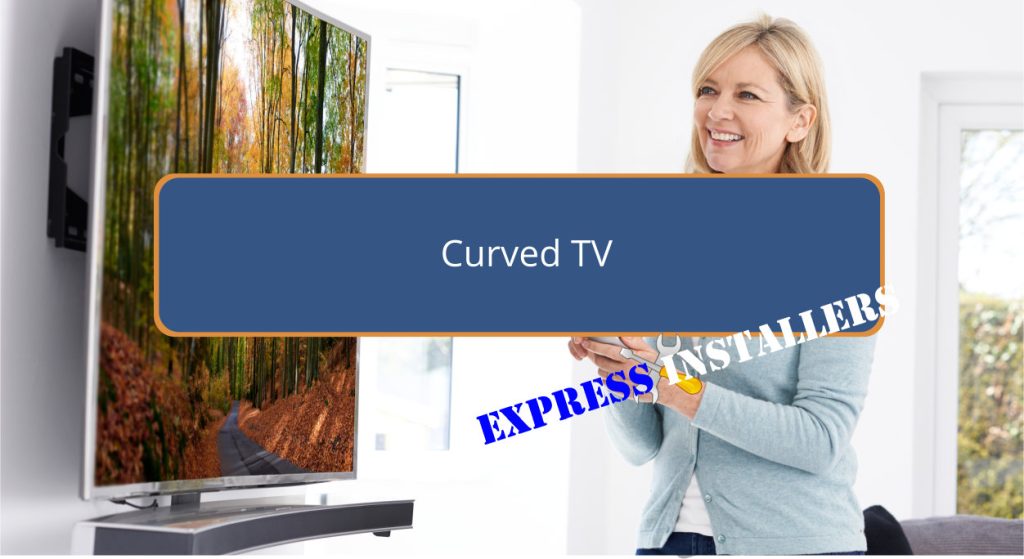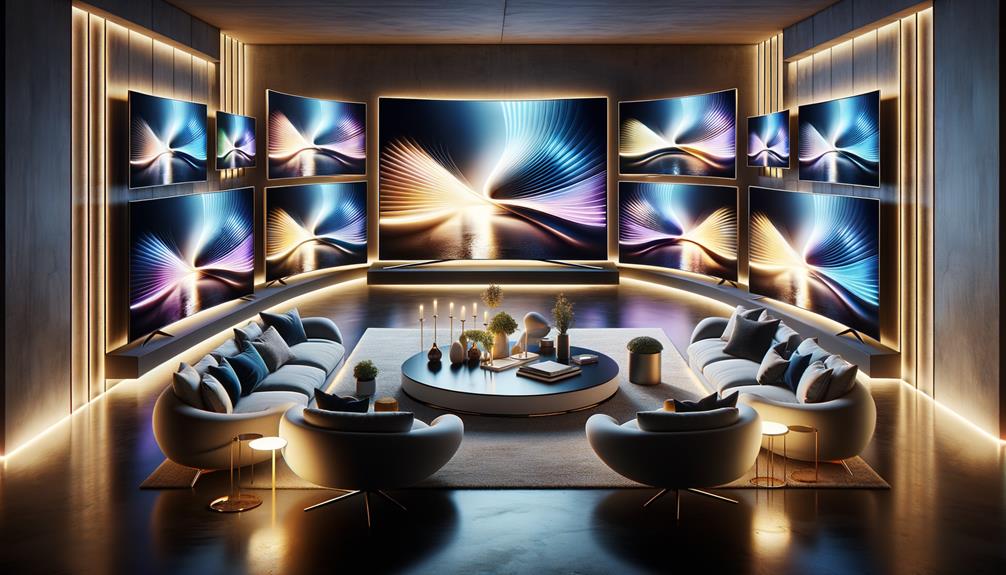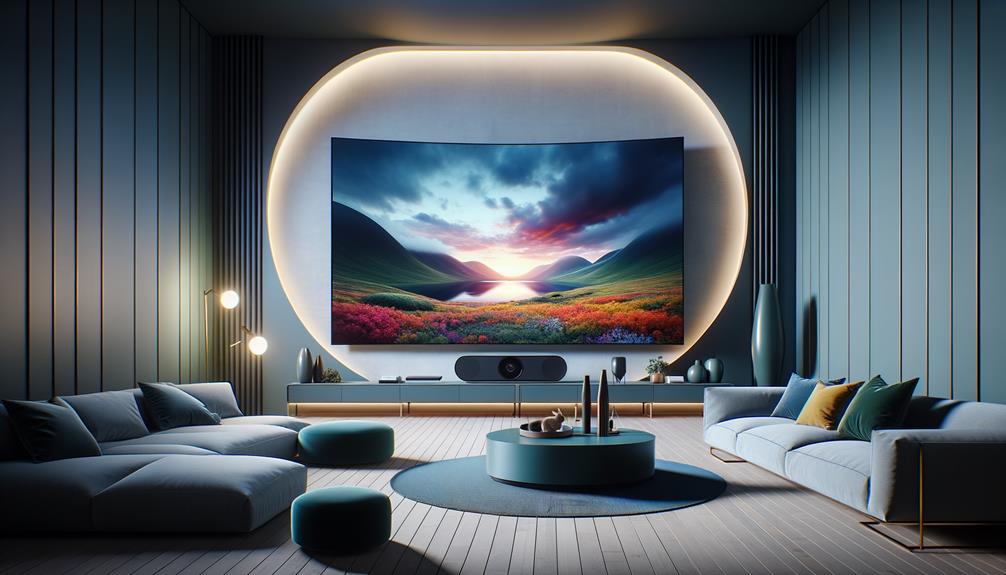
Curved TVs enhance your viewing experience by providing increased depth and a lifelike image quality. They match the natural curvature of your eyes, reducing distortion and ensuring a more comfortable viewing experience.
Advanced features like dynamic contrast adjustment and Screen Mirroring elevate home entertainment. Popular models such as the Samsung TU8300 and LG OLED Flex offer a blend of affordability and cutting-edge technology.
While they require more space and can suffer from glare, they deliver unmatched immersion compared to flat screens.
Exploring further will help you discover the best curved TV model and features for your needs.
Curved TVs offer several unique benefits, starting with an enhanced depth of viewing that creates a 3D-like visual experience.
By curving the screen, these TVs adjust contrast to produce lifelike images, making you feel like you’re part of the action. The design suits the eyes’ natural field of view, which promotes eye comfort during extended watching sessions.
This results in less strain than flat screens, making your viewing experience more enjoyable and more comfortable.
Another advantage is the immersive viewing experience provided by curved screens. The curvature extends the range of angles from which you can view the screen without compromising picture quality.
This means you can sit off to the side and enjoy a clear, vibrant picture. Major brands like Samsung have invested heavily in this technology, ensuring superior picture quality that enhances the viewing experience.
Furthermore, even cheaper curved TVs come with smart features like Screen Mirroring and Catch Up TV, enhancing your home entertainment setup. These features, combined with the screen’s enhanced depth and lifelike images, guarantee that you get a premium viewing experience without breaking the bank.
Understanding the technology behind curved screens reveals the sophisticated engineering that enhances your viewing experience. The screen curvature in these TVs is meticulously designed to match the natural curvature of your eyes.
This alignment reduces the distortion commonly seen in flat screens, providing consistent image quality across different viewing angles.
Major brands like Samsung have invested heavily in perfecting this technology. They use advanced algorithms to adjust contrast dynamically, ensuring lifelike images that are vivid and engaging.
The screen curvature also significantly creates a sense of depth, giving you a 3D-like visual experience without needing special glasses.
Viewing angles is another critical aspect. Curved screens are engineered to offer a wider field of view compared to flat screens. This means you can sit at various angles around the TV and enjoy excellent picture quality.
The technology minimises the colour and contrast degradation typically occurring when watching from the sides.
Moreover, even budget-friendly curved TVs come equipped with stunning HD and 4K picture quality and smart features. This combination of technology provides a more immersive and superior home entertainment experience, making curved TVs a compelling choice for modern viewers.

When exploring popular curved TV models, you’ll often find Samsung and LG lead the market with innovative and immersive designs. Samsung’s TU8300 Class 55-inch TV is a prime example of a high-quality curved display.
It offers an immersive viewing experience with enhanced contrast and colour accuracy, making it a popular choice among consumers.
On the higher end, LG’s OLED Flex, a 42-inch curved TV priced at £2,699, showcases the brand’s commitment to pushing technological boundaries. This model highlights LG’s secondary focus on curved displays, delivering superior picture quality and a flexible form.
In curved TV comparisons, these models illuminate the market trends where affordability and high-end technology coexist. However, curved TVs have faced challenges such as limited availability, space requirements, and glare issues despite their benefits, space requirements, and glare issues.
These factors have influenced the curved TV market trends, reducing the number of new models available.
Due to the limited new options currently on the market, consumers keen on curved TVs might need to consider searching for used or outdated models. This trend underscores the niche appeal and specific requirements of curved TV enthusiasts.
Many enthusiasts argue that curved TVs offer a more immersive viewing experience than flat TVs due to their enhanced depth and visual appeal. Curved screens are engineered to suit the eyes’ natural field of view, creating a 3D-like effect that can make images appear more lifelike.
This design helps adjust contrast and provides superior image quality, especially in HD and 4K resolutions.
However, flat TVs have their own merits. Let’s break down the key differences:

With the advantages and limitations of curved TVs, let’s explore how to choose the suitable model for your needs. Start by considering the screen size. Larger screens, typically above 55 inches, maximise the immersive experience of a curved TV.
Next, look for resolution capabilities—HD, 4K, or even 8K provide varying levels of picture clarity.
Curved TV installation can be more complex than that of flat screens. Ensure you have the right wall-mount kit and enough space to accommodate the curve. Maintenance is also essential; a gentle, non-abrasive cleaner is recommended to avoid damaging the screen’s curvature.
Here’s a quick comparison to help you decide:
| Feature | Consideration |
|---|---|
| Screen Size | Larger screens enhance the immersive effect |
| Resolution | HD, 4K, 8K |
| Brand | Major brands like Samsung offer reliability |
| Installation | Requires specific wall-mount kits |
| Maintenance | Use non-abrasive cleaners |
Also, opt for smart features like Screen Mirroring to enhance your home entertainment experience. Focusing on these factors allows you to select a curved TV that delivers quality and value.
Curved screens are being phased out due to market trends and high production costs. Consumers’ preferences have shifted, and the practicality issues make these devices less appealing, leading manufacturers to focus on more viable technologies.
You’ll appreciate the enhanced viewing angles and immersive experience when considering this. Curved screens align with your natural field of view, delivering lifelike images and a unique 3D-like effect, making it a worthwhile investment.
Curved TVs are still available but have decreased due to declining market demand. Manufacturers like Samsung have shifted focus to other technologies, reflecting changing consumer preferences and practical concerns with curved TV designs.
You’ll face limited viewing angles and challenging wall mounting with these TVs. Their shape can cause glare issues in bright rooms and require more space. These factors can diminish the overall viewing experience, especially in smaller rooms.
When weighing curved TVs against flats, consider the immersive benefits, advanced technology, and standout models. Curved screens might enhance your viewing experience but also come with higher costs and specific viewing angles. By understanding these factors, you can make a well-informed decision.
Ultimately, the suitable TV depends on your personal preferences and space requirements. Carefully evaluate both options, and you’ll find the perfect fit for your entertainment needs.
Mon-Fri: 24 Hours
Sat: 24 Hours
Sun: 24 Hours